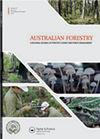Effects of tree spacing on branch-size development during early growth of an experimental plantation of Eucalyptus pilularis in subtropical Australia
IF 1.2
4区 农林科学
Q3 FORESTRY
引用次数: 11
Abstract
ABSTRACT Branch development in trees 1.6–5.7 years after planting was studied in a plantation experiment involving Eucalyptus pilularis in subtropical eastern Australia. The experiment compared stocking densities at planting in the range of 816–1667 stems ha−1 and rectangularities of tree spacing in the range of 1–6. Branch diameters at their bases were measured on the lowest 5 m of the stems of trees judged likely to yield sawn timber of high quality at final harvest. Neither stocking density nor rectangularity had substantial effects on branch numbers or diameters. Particular interest was paid to the presence of branches with diameters in excess of 2.5 cm that might produce knots large enough to degrade the quality of sawn timber. Such branches developed on lower stems between 2–4 years of age. An average of nearly five such branches was found on more widely spaced trees, reducing to 2–3 on more closely spaced trees. The results confirmed other work suggesting that pruning of high-quality eucalypt plantations should start near 2–3 years of age to both limit the development of large branches and restrict the size of knotty cores in logs. There was no evidence that changing the rectangularity of spacing to 3 or a little more, from the more normal practice of close to square, would affect such pruning regimes: increasing the distance between rows can reduce establishment and harvest costs and allow easier access for silvicultural operations.澳大利亚亚热带毛桉试验林生长初期树间距对枝条大小发育的影响
摘要:在澳大利亚东部亚热带地区进行了一项涉及毛桉的人工林试验,研究了种植1.6–5.7年后树木的枝条发育。该实验比较了816–1667茎ha−1的种植密度和1-6的树间距矩形度。底部的枝条直径是在树干的最低5米处测量的,这些树干被认为可能在最终收获时产生高质量的锯材。放养密度和矩形度对枝条数量或直径都没有显著影响。特别关注的是直径超过2.5厘米的树枝的存在,这些树枝可能会产生大到足以降低锯木质量的结。这些枝条在2-4岁之间在较低的茎上发育。在间隔较宽的树木上平均发现近5个这样的树枝,在间隔较近的树木上减少到2-3个。该结果证实了其他工作,即高质量桉树人工林的修剪应在2–3岁左右开始,以限制大枝的发育,并限制原木中多节果核的大小。没有证据表明,将间距的矩形度从更正常的接近正方形的做法改为3或更大一点会影响这种修剪制度:增加行与行之间的距离可以降低建立和收获成本,并使造林作业更容易进行。
本文章由计算机程序翻译,如有差异,请以英文原文为准。
求助全文
约1分钟内获得全文
求助全文
来源期刊

Australian Forestry
FORESTRY-
CiteScore
3.70
自引率
4.80%
发文量
15
审稿时长
>12 weeks
期刊介绍:
Australian Forestry is published by Taylor & Francis for the Institute of Foresters of Australia (IFA) for scientific, technical, and professional communication relating to forestry in the Asia Pacific.
 求助内容:
求助内容: 应助结果提醒方式:
应助结果提醒方式:


